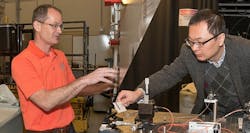Clemson $3.2M DOD grant supports COMSET quest for weapons-grade laser
Star Wars weapons could soon move to the real battlefield with the help of two Clemson University (Clemson, SC) engineers who are receiving a combined $3.2 million from the US Department of Defense (DOD). John Ballato and Lin Zhu are taking two different but complementary approaches to creating a high-energy laser that could be used as a weapon.
RELATED ARTICLE: Testing sets pace for solid-state laser weapons
Both are grappling with the odd things that happen to light at extremely high intensity. The military has already deployed some lasers as defensive weapons to shoot down incoming missiles and drones. Ballato's and Zhu's work is the latest example of how Clemson researchers have carved out a niche in laser-weapon research. Since 2011, five have received a total of nearly $16 million from the DOD High-Energy Laser Joint Technology Office.
In the latest round of funding, Ballato's focus is on the optical fiber that channels the light. His challenge is to figure out what materials should be used to make the optical fiber so that they do not decrease the laser’s power; learn more about Ballato's research here.
Zhu is working on diodes that convert electricity to light. The main challenge for him is engineering a highly powerful light beam that also goes in one direction, a difficult combination; learn more about Zhu's research here.
Much of the laser research is based out of what is commonly called COMSET, which stands for the Center for Optical Materials Science and Engineering Technologies at Clemson's Advanced Materials Research Laboratory in Anderson County. Ballato, the former COMSET director, said that Clemson's edge in laser research can be traced back to the late 1990s.
At the time, all the optical-fiber research was primarily focused on telecommunication. It was the early boom days of the internet and optical fiber is what carries internet traffic. Ballato and other Clemson researchers looked for an underserved market and found one in the DOD. "Time and again we've listened to what they needed," he said. "We've written proposals specifically targeting new ideas around what they need. The testament is in the funding. We've delivered on those problems. We just keep on doing it."
Clemson has maintained its relationship with the military through two wars while building up research infrastructure and expertise. COMSET now has the only industry-grade optical fiber capability at a U.S. university. The university's facilities include a two-story draw tower that allows researchers to create optical fiber. A team of researchers complement each other by focusing on different parts of a laser.
Ballato is the J. E. Sirrine Textile Foundation Endowed Chair of Optical Fibers and has received $1.8 million in his latest round of funding. Zhu is an associate professor of electrical and computer engineering and has received $1.4 million. Both have options to extend their research if the Defense Department likes the results.
Other Clemson researchers to receive money from the High-Energy Laser Joint Technology Office include Liang Dong, associate professor of electrical and computer engineering, and Eric Johnson, PalmettoNet Endowed Chair in Optoelectronics. Joe Kolis, a professor of inorganic chemistry, has been a key collaborator on laser-focused research.
SOURCE: Clemson University; http://newsstand.clemson.edu/mediarelations/laser-weapons-could-go-from-big-screen-to-battlefield-with-engineers-help/
About the Author

Gail Overton
Senior Editor (2004-2020)
Gail has more than 30 years of engineering, marketing, product management, and editorial experience in the photonics and optical communications industry. Before joining the staff at Laser Focus World in 2004, she held many product management and product marketing roles in the fiber-optics industry, most notably at Hughes (El Segundo, CA), GTE Labs (Waltham, MA), Corning (Corning, NY), Photon Kinetics (Beaverton, OR), and Newport Corporation (Irvine, CA). During her marketing career, Gail published articles in WDM Solutions and Sensors magazine and traveled internationally to conduct product and sales training. Gail received her BS degree in physics, with an emphasis in optics, from San Diego State University in San Diego, CA in May 1986.
